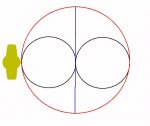Omnis work on pressure, figure 8's work on velocity; cardioids are an equal mixture of the two.
An omni is simply a mic with only oneside exposed to the sound, so that it responds to pressure, not direction. A figure 8 responds to velocity and the sound comes in equally from the front and back.
The back sound gets in thru a large opening behind the mic. As you shut off the back opening, the mic becomes more and more like an omni.
Look at the three heads on an Oktava MC012. The omni has no slotted openings, the cardioid has a couple, and the hypercardioid has more. Look at the pattern layout of any multipattern mic; it's always omni at one end and figure 8 at the other end. All the other inbetween patterns are just varying mixtures of these two patterns, with cardioid being equal proportions of both patterns and always in the center of pattern choices.
Here's the breakdown:
Omni = 100% Omni Pattern, 0% Figure 8 Pattern
Wide Cardioid = 75% Omni Pattern, 25% Figure 8 Pattern
Cardioid = 50% Omni Pattern, 50% Figure 8 Pattern
HyperCardioid = 25% Omni Pattern, 75% Figure 8 Pattern
Figure 8 = 0% Omni Pattern, 100% Figure 8 Pattern
Or you could say:
Omni = 100% Pure Pressure Pattern, 0% Velocity Pattern
Wide Cardioid = 75% Pure Pressure Pattern, 25% Velocity Pattern
Cardioid = 50% Pure Pressure Pattern, 50% Velocity Pattern
HyperCardioid = 25% Pure Pressure Pattern, Velocity Pattern
Figure 8 = 0% Pure Pressure Pattern, 100% Pure Velocity Pattern

 )
)


